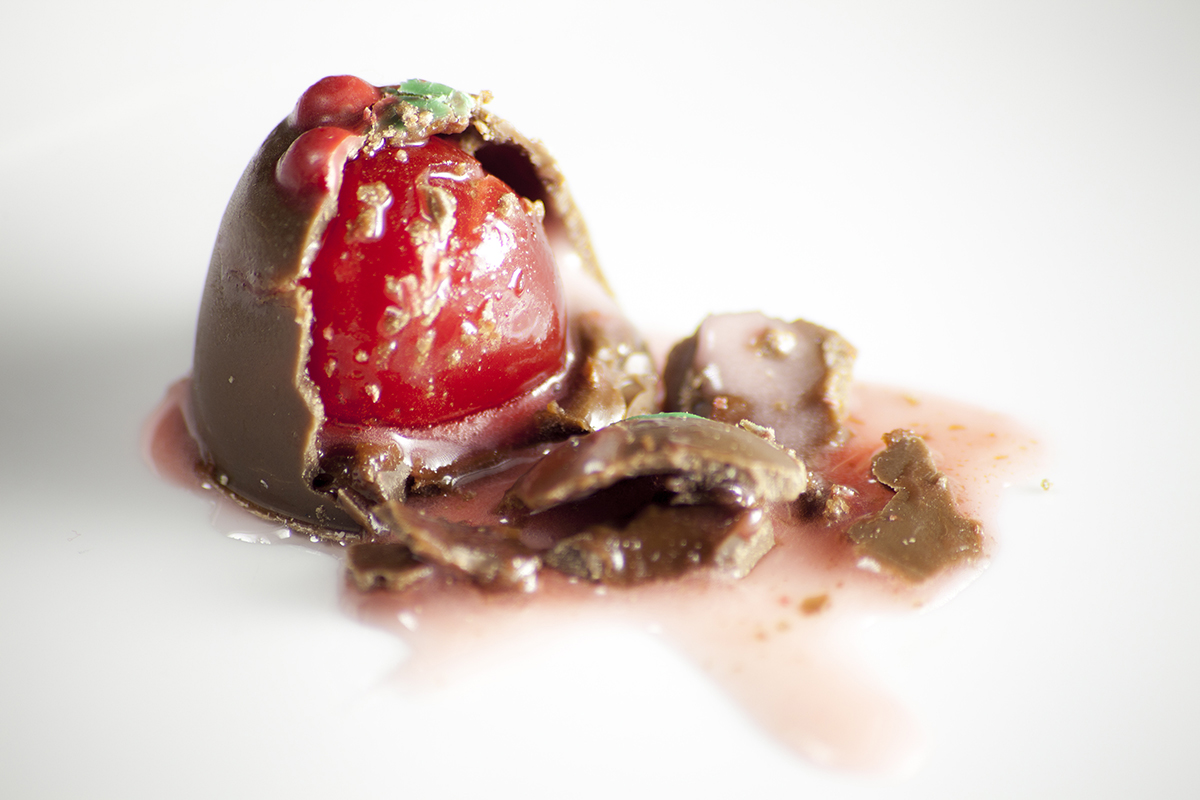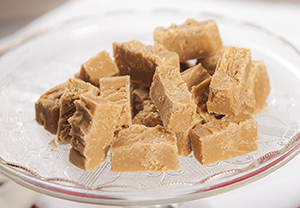Homemade for the holidays
By Allison Griffin
 Many of our most treasured holiday traditions involve the kitchen. Memories continue to be made around the table; the warmth of the stove and the smells of fresh-cooked foods lure friends and family eager to get the first taste of homemade delicacies, many of which are only made at Christmastime.
Many of our most treasured holiday traditions involve the kitchen. Memories continue to be made around the table; the warmth of the stove and the smells of fresh-cooked foods lure friends and family eager to get the first taste of homemade delicacies, many of which are only made at Christmastime.
I have fond memories of my grandmother in her bright yellow kitchen, making batches of Christmas candy for guests and to give as gifts. These were true treasures – divinity and chocolate and peanut butter fudge, richer and more flavorful than any store-bought sweets. Once the Christmas gifts and decorations were put away and the last crumb of candy was gone, we knew it would be the last of it until the next year.
I watched her, with her candy thermometer and steely patience, making sure each batch was perfectly created, cooled and cut. She’d explain her cooking process, which I now know was the key: A hand-written recipe can’t adequately capture a seasoned cook’s special touch.
Such a memory is familiar to Ellen Gregg, a member of the Tombigbee Electric Cooperative whose father, H.T. “Bud” Gregg, was on the Tombigbee board for many years. Her mother, Alice, was famous for her Christmastime peanut brittle, though the recipe was the same one printed on the Karo corn syrup bottle.
“Like a lot of old recipes, it is not enough to just know the recipe. You have to watch how they made the recipe,” Gregg says.
Gregg recalls that the reason everyone loved her mother’s brittle was because she put in more peanuts than the recipe called for. She would butter her old-fashioned porcelain-top kitchen table and pour her brittle batter onto it, using two spatulas or wooden spoons to pull it out as much as she could before it cooled and hardened, which made it thin and lacy.
Another key that Gregg remembers: Putting in the peanuts early enough in the process so they would cook slightly, but not burn. “People would tell Mother that they tried to follow the recipe, but theirs did not turn out like hers.”
Karo syrup is at the heart of another favorite candy (especially in the South) that dates back at least a century. Who can resist the sweet little meringue confections known as divinity?
Divinity, like other candies made from a sugar syrup base, requires precision. A long-held rule of thumb is to make such candies on a day when the humidity is less than 60 percent, because high humidity can affect the texture of soft caramels and hard candy.
Timing and temperature key to perfect divinity
But Sharon Green, owner with her husband Dennis of Nuts to Go in Dothan and a member of Wiregrass Electric Cooperative, says she can churn out a perfect batch of divinity, regardless of the weather. The key, she said, is patience, timing and temperature.
Green recalls watching her mother make delicious divinity and the old-fashioned fudge made with Hershey’s cocoa that was dropped by the spoon, not cut in a pan into squares.
But when Green started making divinity herself as an adult, she couldn’t turn out a batch nearly as good. After innumerable practice batches (including a few that a family member referred to as “divinity soup”), she finally hit on a can’t-miss process.
“It’s actually to do with the timing has to be perfect, and the temperatures have to be perfect. I use timers, and I use the same thermometer,” Green says.
But there’s no substitute for experience.
“There’s a look, and a timing, and a temperature. If you alter in one, you can lose the whole batch,” Green says.
[hr]
Tips to remember when making candy at home:
- If you’re using a thermometer you’re unfamiliar with, place it in a saucepan of boiling water; it should read 212 degrees Fahrenheit. If it doesn’t, adjust the recipe temperature based on the results of the test. The thermometer helps gauge the consistency of the sugar syrup.
- If your recipe calls for nuts, try roasting the nuts first before adding chocolate or other ingredients; that may enhance the flavor.
- Keep moisture away from melted chocolate. Even a small drop can make the chocolate “seize,” or clump and harden.
- Let candy set up completely before wrapping or storing it. Use wax paper to wrap the candy, or to separate layers in gift boxes.
- Use the best ingredients. Don’t skimp, especially on chocolate.
- Store hard and soft candies in separate airtight containers to avoid changes in texture.
- When giving candy as a gift, try a few special presentation touches. Use miniature boxes, woven baskets or decorative jars; decorate the packages with handmade nametags, raffia bows or miniature ornaments.
Sources: Taste of Home web site; Ellen Burkett, Carolyn Adams and Sandra Lewis of Priester’s Pecans in Fort Deposit
[box]
HOLIDAY CANDY RECIPES
The first two recipes were made by Alabama Living managing editor Allison Griffin’s grandmother, Inez Moye Wilder, at holiday time:
Chocolate Fudge
3 cups sugar
1 envelope unflavored gelatin
1 cup milk
½ cup light corn syrup
3 squares unsweetened chocolate
1¼ cups butter
2 teaspoons vanilla extract
1 cup nuts
Butter an 8-by-8-by-2-inch pan. In a 3 ½ quart saucepan, mix sugar with dry gelatin. Add milk, corn syrup, chocolate and butter. Cook over medium heat, stirring frequently to 238 degrees Fahrenheit on a candy thermometer, or until the mixture forms a soft ball when dropped in a little cold water and flattens when removed from water.
Remove from heat; pour into a large mixing bowl. Stir in vanilla. Cool for 25 minutes. Beat with a wooden spoon until candy thickens; spread into the pan. Let cool about 30 minutes, then cut into squares. Makes about 2 ½ pounds.
[hr]
 Peanut Butter Fudge
Peanut Butter Fudge
Mix three cups brown sugar and 1 cup sweet milk thoroughly. Boil until the syrup forms a soft ball when dropped into cold water. Remove from heat and add ¾ cup peanut butter. Beat until thick; pour into a buttered pan and cut into squares when completely cooled.
[hr]
Ellen Gregg’s mother, Alice Hardwick Gregg, used this classic recipe and tweaked it to make it her own:
Peanut Brittle
1 cup light or dark corn syrup
1 cup sugar
¼ water
2 tablespoons butter or margarine (she preferred butter)
2-3 cups roasted, lightly salted peanuts
1 teaspoon baking soda
Combine syrup, sugar, water and butter in a heavy 3-quart saucepan. (The heavier, the better!) Cook over medium heat, stirring frequently, until sugar dissolves and mixture comes to a boil.
Cook without stirring until temperature reaches 280 degrees Fahrenheit on a candy thermometer or small amount of mixture dropped into very cold water separates into threads which are hard but not brittle.
Gradually stir in peanuts; continue cooking, stirring frequently, until temperature reaches 300 degrees Fahrenheit or small amount of mixture dropped into very cold water separates into threads which are hard and brittle. Remove from heat; stir in baking soda. Mixture will foam and become lighter in color.
Immediately pour mixture onto prepared metal, enamel, or porcelain table. (If you don’t have one of these, well bless your heart, just do the best you can!) With metal spatula (or any instrument handy, as it will burn and stick to your skin!), frantically spread mixture out as far as you can get it, before it cools. Then hide some for yourself, or you might not get any!
Ellen Gregg, Tombigbee EC
[hr]
This is a classic recipe for divinity from the Karo corn syrup company, with a couple of notes from baker and Nuts to Go shop owner Sharon Green of Dothan:
Divinity
2½ cups sugar
½ cup Karo light corn syrup
½ cup water
¼ teaspoon of salt
2 egg whites, room temperature
1 teaspoon vanilla extract
1 cup chopped nuts (optional)
In a heavy saucepan, combine sugar, corn syrup, water and salt. Stirring constantly, bring to boil over medium heat. Without stirring, cook over low heat (small to medium bubbles breaking across the surface of the liquid) until the temperature reaches 260 degrees Fahrenheit, or the hard ball stage.
In a large stand mixer, beat egg whites at high speed until stiff peaks form. Beating at high speed, very slowly add hot syrup in a thin, steady stream (this can take several minutes.) Don’t scrape the side of the saucepan. Continue beating at high speed until mixture begins to lose its gloss, about three minutes.
Reduce speed to low. Beat in vanilla. Continue beating at low speed until mixture holds a peak and doesn’t spread when dropped from a spoon, about eight minutes. (If mixture becomes too stiff for mixer, beat with a wooden spoon.) Immediately stir in nuts with a spoon.
Working quickly, drop by teaspoons (one to dip into batter, the other to roll it into a ball) onto waxed paper. Garnish with walnut pieces, a pecan half or candied cherries, if desired. Let stand until set.
Sharon Green, Wiregrass EC
[hr]
The following two recipes are from Alabama Living’s “Southern Occasions” cookbook, which features recipes submitted by cooperative members:
Crock Pot Candy
16 ounces peanuts, dry roasted and salted
16 ounces peanuts, dry roasted and unsalted
1 bar German sweet chocolate
12 ounces milk chocolate chips
1½ bars white almond bark
In a large crockpot, layer the ingredients in the order listed. Do not mix or stir. Heat on low for two hours. Do not lift lid. After two hours, stir well and drop by teaspoonful onto wax paper. Let cool.
Shari Taylor, Central Alabama EC
[hr]
Strawberry Divinity
3 cups sugar
1 small package strawberry Jell-O
¾ cup light corn syrup
¾ cup water
2 stiffly beaten egg whites
1 cup chopped pecans (optional)
½ cup coconut (optional)
In large saucepan bring sugar, corn syrup and water to a boil, stirring constantly. Reduce heat and cook to hard ball stage. Combine egg whites with Jell-O until mixed. Pour syrup in a thin thread over egg whites and Jell-O mixture. With mixer on high, beat until all syrup is used, continuing to beat until the candy is cool and has a smooth look. Using two teaspoons, drop onto wax paper. If candy is too hot to drop, cool only a few seconds, or beat with a spoon a few seconds. Continue to drop onto wax paper. This candy sets up rather fast and makes about 50 pieces. (If coconut is used, I usually omit pecans.)
Shirley Masters, Wiregrass EC
[/box]





